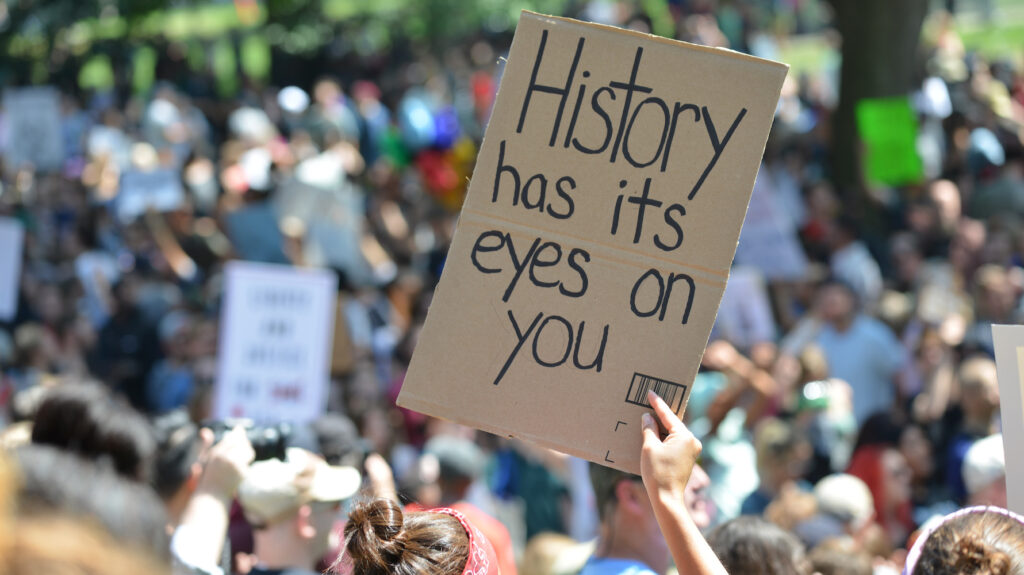The root cause of the insanity on college campuses is older than you may think
(The Daily Signal) – Americans are finally catching on that the oppressor-oppressed narrative being taught in our schools and universities is not a conspiracy theory disseminated by…

(The Daily Signal) – Americans are finally catching on that the oppressor-oppressed narrative being taught in our schools and universities is not a conspiracy theory disseminated by conservatives. It’s real. Jewish students having to barricade themselves in a college to escape a mob in Manhattan, of all places, has opened people’s eyes to the threat woke ideology represents to civilization.
Too bad it took a grotesque massacre and mass rapes in the Holy Land to do it. But now that we have people’s attention, let’s connect the dots.
The oppressor-oppressed worldview that paints democratic Israel as the “oppressor” and Palestinian terrorists as the “oppressed,” so prevalent on college campuses, is pure Marxism.
In the first page of “The Communist Manifesto” of 1848, Karl Marx and Friedrich Engels explain that “The history of all hitherto existing society is the history of class struggles.” They add:
Freeman and slave, patrician and plebeian, lord and serf, guild-master and journeyman, in a word, oppressor and oppressed, stood in constant opposition to one another, carried on an uninterrupted, now hidden, now open fight, a fight that each time ended, either in a revolutionary reconstitution of society at large, or in the common ruin of the contending classes.
Capitalism and democracy are based on competition, but competition requires compromise and that gives each side something.
In the economic sphere, buyer and seller haggle over a price (or in most cases, millions of buyers and sellers known abstractly as “the market” do) to come up with a “market-clearing price” that allows buyer and seller to walk away with some measure of satisfaction.
In a democracy, one party or side seldom gets all it wants. And if the system is correctly structured, as the founders strived to do with the American system of government, there are checks and balances. The legislature, the executive, and the judiciary check each other’s powers (and the legislature itself is divided into two chambers).
Not so in Marx’s “oppressor and oppressed” view. There you end up with a “revolutionary reconstitution,” which Marx himself promised would be ruthless. “This cannot be effected except by means of despotic inroads,” he averred in the manifesto.
A few months later, Marx wrote, more ominously, “There is only one way in which the murderous death agonies of the old society and the bloody birth throes of the new society can be shortened, simplified and concentrated, and that way is revolutionary terror.”
Blood will run—it’s a feature, not a bug, of Marxism.
What we are seeing right now is no longer economic Marxism, but cultural Marxism. In 1888, Engels added a footnote to the Manifesto’s first page that explained the two classes that were contending.
By bourgeoisie is meant the class of modern capitalists, owners of the means of social production and employers of wage labour. By proletariat, the class of modern wage labourers who, having no means of production of their own, are reduced to selling their labour power in order to live.
The problem was that, as Marxists from the end of World War I in 1918 to the 1960s were able to document, the actual proletariat had very little interest in “revolutionary reconstitution of society at large.” In the 1920s in Europe, and in the 1960s here in America, they wanted better working conditions, and maybe a week or two at the beach every year.
But they didn’t want to “abolish” the family, the nation state, property, or God, as Marx had called for. In fact, they wanted to become richer and move up a class. It turned out that Marx had never spent much time with actual workers, and didn’t understand them. He was the original limousine Marxist.
In the 1960s, the Marxist theorist Herbert Marcuse derided the workers for being such bad revolutionaries. “They find their soul in their automobile, hi-fi set, split-level home, kitchen equipment,” wrote the despairing Marcuse.
But then Marcuse witnessed the riots of the 1960s, and wrote that—in his words—the revolution would come from the “ghetto population.” The vanguard of the revolution, he added, would therefore have to come from “the substratum of the outcasts and outsiders, the exploited and the persecuted of other races and other colors.”
Since then, the revolutionary locus has been placed not in economic classes, but in cultural identities.
Marx had written in 1859 that revolutions would inevitably come when “the material forces of production in society come into conflict with the existing relations of production.” But Antonio Gramsci, one of Marcuse’s cultural Marxist precursors, added in 1930s that “popular beliefs and similar ideas are themselves material forces.”
Eric Mann, the former Weatherman terrorist who recruited Black Lives Matter founder Patrisse Cullors at the age of 17 to train her into Marxism, later added: “Given the social formation of the U.S. as a settler state based on virulent white supremacy, the racialization of all aspects of political life operates as a material force in itself.”
That’s how we get from economic Marxism to the mess we have today on U.S. campuses. “Pedagogy of the Oppressed,” for example, the Marxist tract penned by Paulo Freire, has “achieved near-iconic status in America’s teacher-training programs,” according to Sol Stern.
Many of us have been explaining for years, in books, papers, op-eds, media interviews, and speeches, that what we are seeing is “cultural Marxism.” That, too, has been dismissed. Google “cultural Marxism” and the very first entry is a Wikipedia page that informs the reader that “The term ‘Cultural Marxism’ refers to a far-right antisemitic conspiracy theory.”
They’ll have a harder time hiding the truth now.



